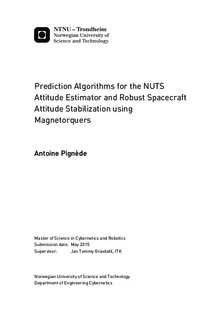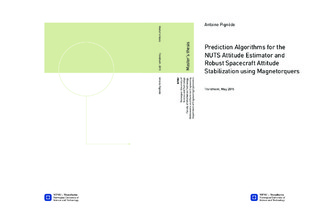| dc.description.abstract | Prediction Algorithms for the Attitude Estimator
The attitude estimator is an extended Kalman filter, a recursive algorithm to treat noisy inputs to a dynamical system. The filter is optimal to compute the system s states. One of the steps involves a model representation of the system. In the case of the attitude dynamics of a satellite that has sun sensors and a magnetometer, this requires prior knowledge of the position of the sun with respect to the satellite and the magnetic flux density vector of the earth s magnetic field at the satellite location.
These problems have all been solved already, good software is available online and no new discovery was made here. The innovation is the integration of these software parts, the harmonization of their interfaces and the legitimate simplifications done to prevent too high complexity on restricted hardware. The digital attachment contains ready to use software and test procedures for the further development of the attitude determination and control system. The thesis describes the theory and serves as user s guide for the five parts
1. Time Conversions: The algorithms depend on time. Different time systems (e.g. universal time, terrestrial time) and time representations (e.g. time and date, day of the year) are advantageous dependent on the application. The user deals only with the time and date representation of universal time.
2. Frame Transformations: As with the time, some reference frames are better suited than other for particular tasks. The user only sees vectors expressed in the Earth-Centered Inertial Frame, but internally a lot of transformations occur.
3. Sun Vector Predictor: A low accuracy Astronomical Almanac sun vector algorithm is used. The satellite is so close to the earth that there is no difference in the vector from the earth s centre to the sun compared to the vector from the satellite to the sun.
4. Orbit Position and Velocity Prediction: This is also called orbit propagation. The Simplified General Perturbations 4 propagator is used. It needs the Two-Line Element Set for NUTS for the orbit description and returns the satellite position needed for the next predictor. The velocity can be useful for the attitude controller.
5. Geomagnetic Field Prediction: There are currently two equally precise models implemented, The World Magnetic Model 2015 and The 12th Generation International Geomagnetic Reference Field. Of course only one is necessary for the satellite. Hardware tests suggest to use the World Magnetic Model because it runs faster.
Robust Spacecraft Attitude Stabilization using Magnetorquers
Attitude control of a spacecraft with magnetic coils as only actuators does not suffice to attain and maintain any desired attitude. However if the aim is to stabilize the spacecraft such that one axis points to the earth, there are formal proofs that magnetorquers provide enough control action for the stabilization under certain assumptions. This chapter extends two such proofs. The need of knowledge of the spacecraft inertia is relaxed and no special property on the earth s magnetic field is required.
The first controller is a nonlinear D controller. A strict Lyapunov function is found with help of Matrosov s theorem. If the unknown inertia is viewed as the (small) perturbation of an estimate, the controller still stabilizes the attitude globally, uniformly and asymptotically.
The second controller is designed with the sliding mode control method. If the torque that the unknown inertia raises, is viewed as part of a (small) disturbance, the controller still stabilizes the attitude globally, uniformly and asymptotically. | |

